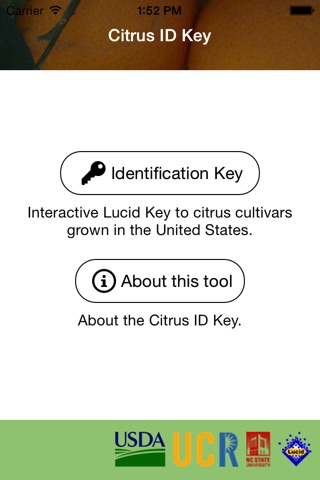
Citrus ID
Utvecklare: United States Department of Agriculture-APHIS
Citrus pests and diseases may be found on a number of plant species in various plant families. The Citrus ID Key is primarily intended to help people working or conducting pest surveys in citrus orchards, variety collections, and home gardens, so its focus is limited exclusively to the citrus family (Rutaceae). Although eight genera of Rutaceae are native to the continental United States (Amyris, Choisya, Cneoridium, Esenbeckia, Helietta, Ptelea, Thamnosma, and Zanthoxylum), most of these are unlikely to be encountered in our target locations and can be keyed using regional guides. The cultivars and taxa of citrus and relatives that have been introduced and released for cultivation are the most likely to be encountered in cultivated settings, so the Citrus ID Key concentrates on these taxa.
Cultivars of citrus and its relatives are released in the United States through state agencies and to a lesser extent the USDA-ARS National Clonal Germplasm Repository for Citrus & Dates. Our target list of entities was synthesized from the cultivar lists provided by the California Citrus Clonal Protection Program, the Florida Citrus Arboretum, the Florida Chiefland Budwood Distribution Center, the Florida Bureau of Citrus Budwood Registration, and the Texas Budwood Certification Program. Arizona no longer certifies budwood, instead relying on the California program. The resulting target list includes over 500 entities of citrus and relatives cultivated in the United States.
Field identification to the level of cultivar remains impossible in most cases. This is partially due to the complicated reticulate breeding history of citrus, but also, selection has generally focused on characters such as taste, disease and stress resistance, and fruiting phenology rather than on characters of ornamental (and thus morphological) value. This key facilitates identification to at least the cultivar group level within citrus (e.g., sweet oranges, sour oranges, etc.), if not beyond for select cultivars.
Original illustrations and photography: Unless specifically indicated otherwise, the source for plant images included in Citrus ID Key should be cited as "Herbarium (NCSC)." NCSC is the official abbreviation for the North Carolina State University Herbarium. Any commercial use is prohibited without express written permission. Requests may be addressed to: Herbarium, Department of Plant Biology, North Carolina State University, Raleigh, NC 27695-7612.
Original source for Lucid Mobile Key: Saville, A.C., A. Krings, T. Kahn, M.D. Trice, and A.J. Redford. 2011. Citrus ID, Edition 2. USDA APHIS PPQ ITP, Fort Collins and North Carolina State University. http://idtools.org/id/citrus/citrusid/
Key authors: Amanda Saville, Alexander Krings, Tracy Kahn, Matthew Trice, and Amanda Redford

